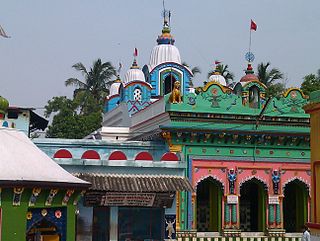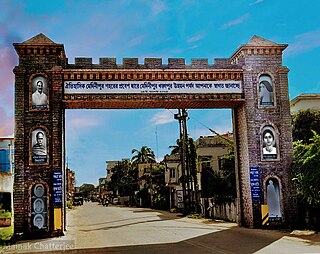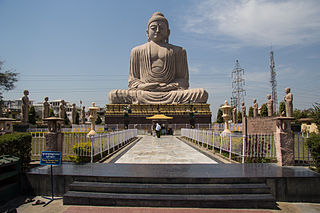
Virgo is one of the constellations of the zodiac. Its name is Latin for maiden, and its old astronomical symbol is . Between Leo to the west and Libra to the east, it is the second-largest constellation in the sky and the largest constellation in the zodiac. The ecliptic intersects the celestial equator within this constellation and Pisces. Underlying these technical two definitions, the sun passes directly overhead of the equator, within this constellation, at the September equinox. Virgo can be easily found through its brightest star, Spica.

Bargarh is one of the major towns of Western Odisha and a municipality in Bargarh district in the state of Odisha in India. It is the administrative headquarters of Bargarh District and an important town of Odisha because it is known as the "rice bowl of Odisha" due to its intense rice production, it is an agro-industrial hub and is also known as "city of handloom" because sambalpuri sari originated from here."Dhanujatra" of Bargarh is world famous and is known as the "world's largest open theatre". Bargarh was awarded with the "fastest moving city" award under the 50k-100k category in Swachh Sarbekhyan 2022 in the east zone.

Balasore, also known as Baleswar, is a city in the state of Odisha, about 215 km (134 mi) from the state capital Bhubaneswar and 300 km (186 mi) from Kolkata, in eastern India. It is the administrative headquarters of Balasore district and the largest city as well as health and educational hub of northern Odisha. It is best known for Chandipur beach. It is also called 'missile city'. The Indian Ballistic Missile Defence Programme's Integrated Test Range is located 18 km south of Balasore.

Medinipur or Midnapore is a city known for its history in the Indian state of West Bengal. It is the headquarters of the West Medinipur district. It is situated on the banks of the Kangsabati River. The Urban Agglomeration of Midnapore consists of the city proper, Mohanpur, Keranichati and Khayerullachak. Midnapore and its neighbouring city of Kharagpur constitute the central core of the Midnapore Kharagpur Development Authority metro area, spread across 576 square kilometres.

Jagatsinghpur District is one of the thirty districts of Odisha in the eastern coast of India. It became a new district on 1 April 1993 being separated from Cuttack district with its own headquarter in Jagatsinghpur town. Deltaic and partly littoral; the district of Jagatsinghpur is triangular in shape and small in geographical proportions. It is the smallest district in the state and covers a landmass of 1759 km2. It has a history of its own dating back to the 6th century AD, having contemporaneity with the Prachi valley civilization. Its archaeological remains, navigation network, inland and overseas trade, fabric manufacturing & designing, religious tolerance and epoch-making glorious role in freedom struggle; have a savor of distinctiveness.

East India is a region of India consisting of the Indian states of Bihar, Jharkhand, Odisha and West Bengal and also the union territory of the Andaman and Nicobar Islands.

Paralakhemundi shortly known as Parala is district Headquarter of Gajapati district and one of the oldest Municipality established in 1885, in the Indian state of Odisha. Majority of the people in the town speak Odia. The city and the District share its boundaries with Andhra Pradesh. The adjacent town of Pathpatnam is separated by the River Mahendra Tanaya.In later medieval period it became capital of Paralakhemundi Estate of Eastern Ganga dynasty kings of Khemundi Branch. The town is well known for being an ancient cultural center of Odisha and birthplace of noted personalities including poet Gopalakrusna Pattanayaka, statesman Krushna Chandra Gajapati Narayan Deo, lexicographer Gopinatha Nanda Sharma and historian Satyanarayana Rajguru. This town is also known for its century old temples, monasteries, palaces and heritage buildings.
Malkangiri, historically known as Malikamardhangiri, is a town and municipality in Malkangiri district in the Indian state of Odisha. It is the headquarter of the Malkangiri district. Malkangiri has been the new home of the East Bengali refugees from erstwhile East Pakistan, who have been rehabilitated since 1965 under the Dandakaranya Project. Some Sri Lankan Tamil refugees were also rehabilitated in the town, following the armed struggle of the Liberation Tigers of Tamil Eelam (LTTE) in the early 1990s, although most of them have now returned to their country. Currently, it is one of the most naxalite-affected areas of the state, and is a part of the Red Corridor.

Choudwar is a town and a municipality in Cuttack district in the Indian state of Odisha. It comes under Bhubaneswar-Cuttack commissionerate.
Anandapur is a town and municipality of Kendujhar district in the state of Odisha, India.
Khariar is a city and a Notified Area Council in Nuapada District of the Indian state of Odisha.

Kiriburu is a census town in Odisha. The town is mainly known for having big Iron-ore Mines KIOM & MIOM both governed by Steel Authority of India Limited (SAIL). The road connecting the township to the mines is divided by the border of Odisha and Jharkhand. It is also a famous hill station situated in the core of Saranda forest. Saranda forest is land of seven hundred hills. The name of the forest Saranda is due to the large number of elephants found in this forest. The forest has some waterfalls.
Nilagiri is a town and a Notified Area Council in Balasore district in the Indian state of Odisha.

Ganjam is a town and a notified area council in Ganjam district in the state of Odisha, India. Brahmapur, one of the major city of Odisha, is situated in this district on the eastern coastline.

Dried shrimp are shrimp that have been sun-dried and shrunk to a thumbnail size. They are used in many African, East Asian, Southeast Asian and South Asian cuisines, imparting a unique umami taste. A handful of shrimp is generally used for dishes. The flavors of this ingredient are released when allowed to simmer.
Baghamari is a village located in the Western part of Khordha district in the Indian state of Odisha. The population is more than 20,000. The meaning of the name of this village is 'Killing the Tigers'. In times prior to Independence of India (1947), the area was deeply forested and populated with wild animals.
Skookumchuck Hot Springs is a hot spring in British Columbia, Canada. Its pre-colonial, Indigenous name is Tsek Hot Spring or T'sek Hot Spring. The former colonial name is Saint Agnes Well. The springs are located near the First Nation community of Skookumchuck, on the historic Harrison Lillooet Gold Rush trail in the Lillooet River valley, south of Lillooet Lake.

Odisha is one of the 28 states in the Republic of India. Odisha is located in the eastern part of the Indian peninsula and the Bay of Bengal lies to its East while Chhattisgarh shares its border in the west and north-west. The state also shares geographic boundaries with West Bengal in the north-east, Jharkhand in the north and Andhra Pradesh in the south. The state is spread over an area of 1,55,707 km2 and extends for 700 km from north to south and 500 kilometres from east to west. Its coastline is 450 km long. The state is divided into 30 districts which are further subdivided into 314 blocks called tahasil.

Deulajhari, the ancient citadel of Shaivism, is located in Deulajhari village in the Angul district of the Indian state of Odisha. This attractive place is having 24 acres (9.7 ha) and 55 decimals of land and covered with indigenous- pandanus forest. It is known for a hot spring and the Shiva Shree Siddeswar Baba temple. There are 24 hot springs around the temple although temple records say that once there were 84 such hot water springs here.
Fategarh is a village in Orissa, located in Bhapur Tehsil in Nayagarh District of Odisha, India. It is 38 km far from its District Main City Nayagarh. It is 60 km far from its state capital Bhubaneswar.














